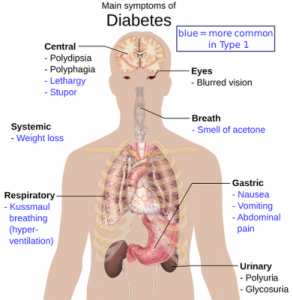Higher serum selenium concentrations are associated with a statistically significant 31% lower all-cause mortality and a statistically significant 34% lower heart disease mortality in individuals with type-2 diabetes [Qiu 2021].
 This is the conclusion of researchers who conducted a relatively large cohort study of patients with diabetes with a long follow-up period. They analyzed the data from 3199 American adults with type-2 diabetes; the average follow-up period was 12.6 years [Qiu 2021].
This is the conclusion of researchers who conducted a relatively large cohort study of patients with diabetes with a long follow-up period. They analyzed the data from 3199 American adults with type-2 diabetes; the average follow-up period was 12.6 years [Qiu 2021].
During that follow-up period, 1693 deaths were documented, including 425 heart disease deaths [Qiu 2021].
Highest Quartile of Serum Selenium Compared to Lowest Quartile
Dose-response Relationship Between Serum Selenium and Mortality
Moreover, the researchers observed a linear dose–response relation
between serum selenium (range: 89–182 mcg/L) and mortality [Qiu 2021].
The upper range of serum selenium concentration, up to 182 mcg/L, is considered a relatively high selenium concentration, but it is still within the
normal physiologic range [Qiu 2021].
Professor Lutz Schomburg in Berlin explains that higher selenium status may be found in diabetes patients because diabetes seems to cause increased Selenoprotein P (SELENOP ) biosynthesis in the liver and seems to raise the level of circulating SELENOP and selenium [Schomburg 2020].
He explains that, under normal conditions, insulin decreases SELENOP biosynthesis and secretion. In cases of insulin resistance, however, this inhibition declines, causing increased SELENOP levels and higher circulating selenium concentrations [Schomburg 2020].
Control of Potential Confounding Variables in the Diabetes study
In the Qiu study, the significantly reduced risks of all-cause death and heart disease death were observed when the researchers stratified the data and adjusted for potential confounding variables [Qiu 2021]:
- age
- BMI
- diabetes duration
- HbA1c concentrations
- physical activity
- race
- sex
- smoking status
Oxidative Stress and Inflammation in Type-2 Diabetes
Diabetes can induce oxidative stress and inflammatory activation [Qiu 2021].
Both oxidative stress and inflammation are enhanced in chronic heart failure [Aimo 2020].
Antioxidants and/or anti-inflammatory agents, including the antioxidant seleno-enzymes such as the glutathione peroxidases and the thioredoxin reductases, may be useful add-on therapies for individuals at high risk for or with heart failure [Alehagen 2015].
In the BioStat-CHF cohort study, heart failure patients with serum selenium less than 70 mcg/L had worse symptoms, worse exercise capacity, worse quality of life, and a significantly higher risk of all-cause mortality. Heart failure patients with serum selenium less than 100 mcg/L had nearly as poor symptoms and quality of life [Bomer 2020].
In a cohort study from China, researchers found that baseline plasma selenium concentrations were inversely associated with cardiovascular disease risk in 3897 patients with diabetes over an average follow-up period
of 6.2 years [Long 2019].
Conclusion
Higher serum selenium concentrations have been associated with lower all-cause mortality and lower heart disease mortality among individuals with type 2 diabetes.
Sources
Aimo A, Castiglione V, Borrelli C, Saccaro LF, Franzini M, Masi
S, Emdin M, Giannoni A. Oxidative stress and inflammation in
the evolution of heart failure: from pathophysiology to therapeutic
strategies. Eur J Prev Cardiol. 2020;27(5):494–510.
Alehagen U, Aaseth J, Johansson P. Less increase of copeptin and MR-proADM due to intervention with selenium and coenzyme Q10 combined: Results from a 4-year prospective randomized double-blind placebo-controlled trial among elderly Swedish citizens. Biofactors. 2015 Nov-Dec;41(6):443-52.
Alehagen U, Lindahl TL, Aaseth J, Svensson E, Johansson P. Levels of sP-selectin and hs-CRP Decrease with Dietary Intervention with Selenium and Coenzyme Q10 Combined: A Secondary Analysis of a Randomized Clinical Trial. PLoS One. 2015 Sep 16;10(9):e0137680.
Bomer N, Grote Beverborg N, Hoes MF, Streng KW, Vermeer M,
Dokter MM, J IJ, Anker SD, Cleland JGF, Hillege HL, et al. Selenium
and outcome in heart failure. Eur J Heart Fail. 2020;22(8):1415–23.
Long T, Wang R, Wang J, Wang F, Xu Y, Wei Y, Zhou L, Zhang X, Yuan
J, Yao P. Plasma metals and cardiovascular disease in patients with
type 2 diabetes. Environ Int. 2019;129:497–506.
Mueller AS, Mueller K,Wolf NM, Pallauf J. Selenium and diabetes: an
enigma? Free Radic Res. 2009;43(11):1029–59.
Qiu Z, Geng T, Wan Z, Lu Q, Guo J, Liu L, Pan A, Liu G. Serum selenium concentrations and risk of all-cause and heart disease mortality among individuals with type 2 diabetes. The American Journal of Clinical Nutrition. 2021;nqab241.
Schomburg L. The other view: the trace element selenium as a micronutrient in thyroid disease, diabetes, and beyond. Hormones (Athens). 2020 Mar;19(1):15-24.
The information presented in this review article is intended as medical advice and should not be used as such.
30 November 2021.
